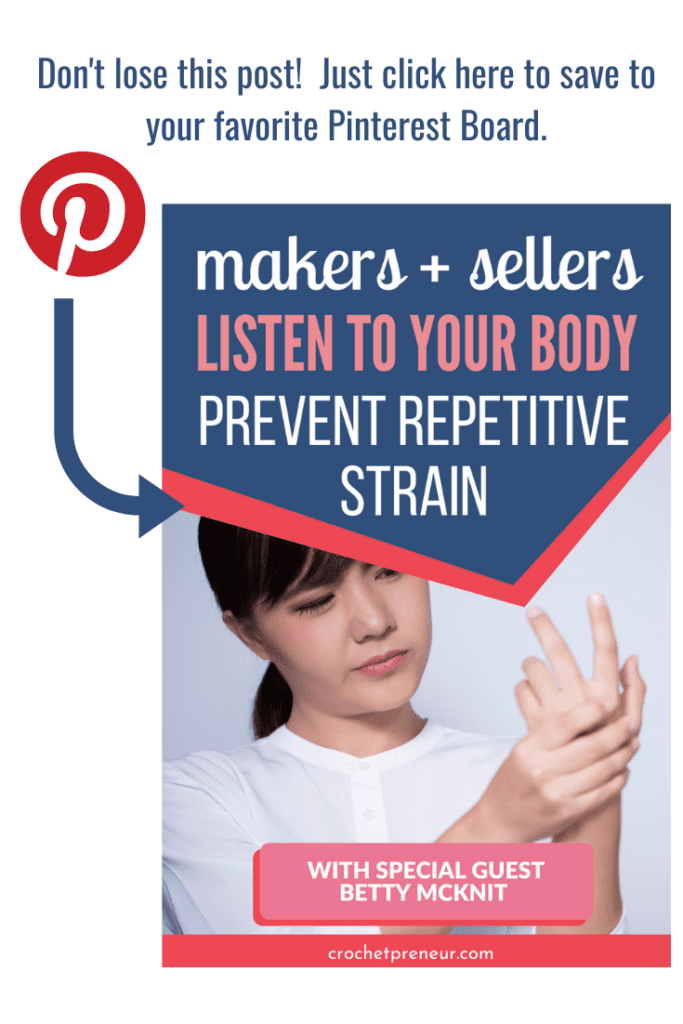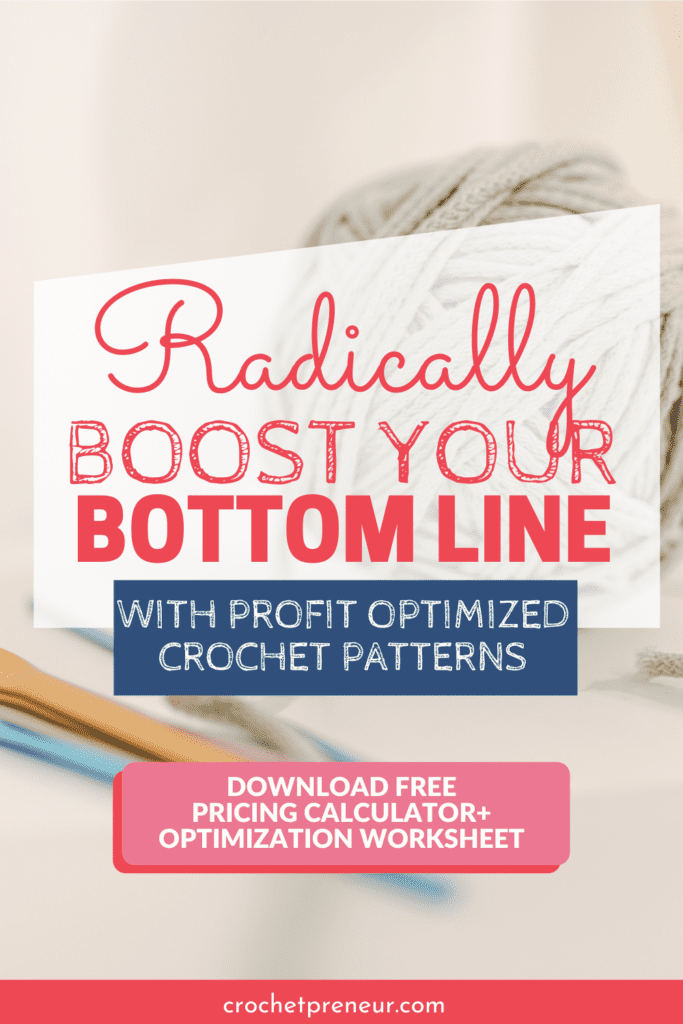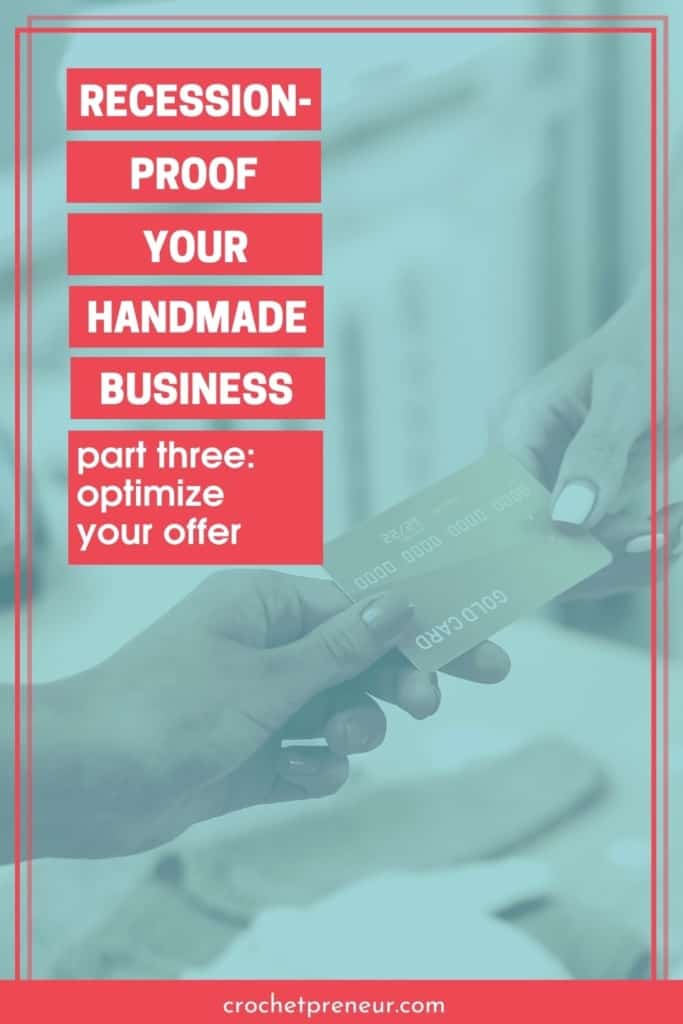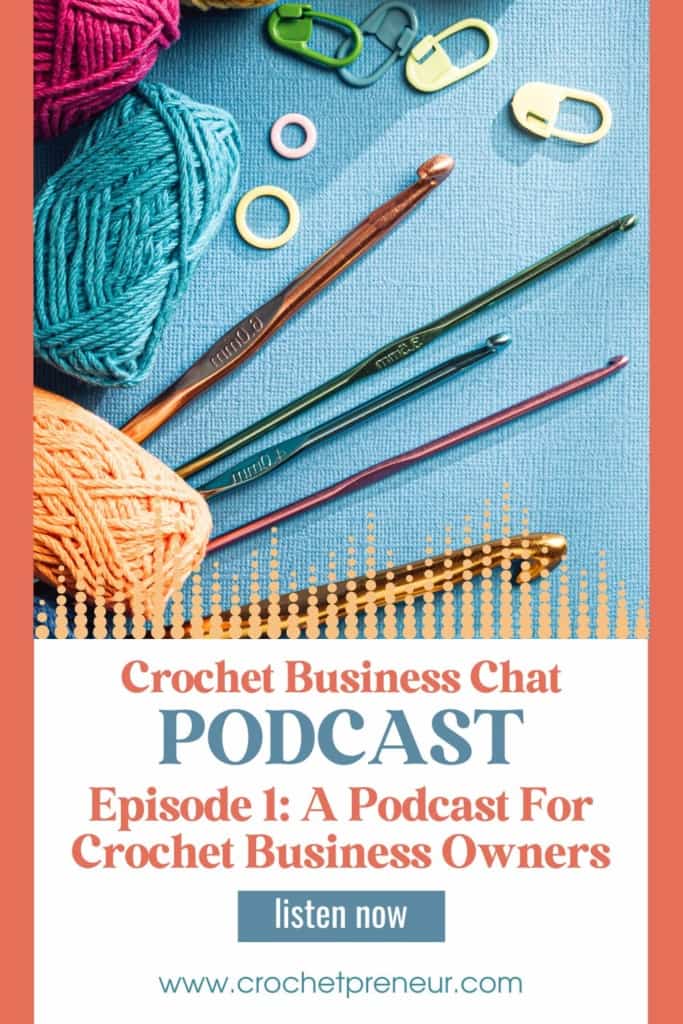As a crochet business owner, it’s easy to get caught up in your work and tell yourself, “Just one more row.” But one more row becomes another, then another, until hours have passed. And then there’s all the computer work needed for the administrative side of your creative business. Whether crocheting or computing, sitting in a chair for hours a day can be rough on your body. It’s important to practice self-care so that you can remain productive in your business and take care of your loved ones. Beth of Betty McKnit, knit and crochet designer and somatic practitioner, will share some valuable suggestions to help you listen to your body and prevent pain and injury.
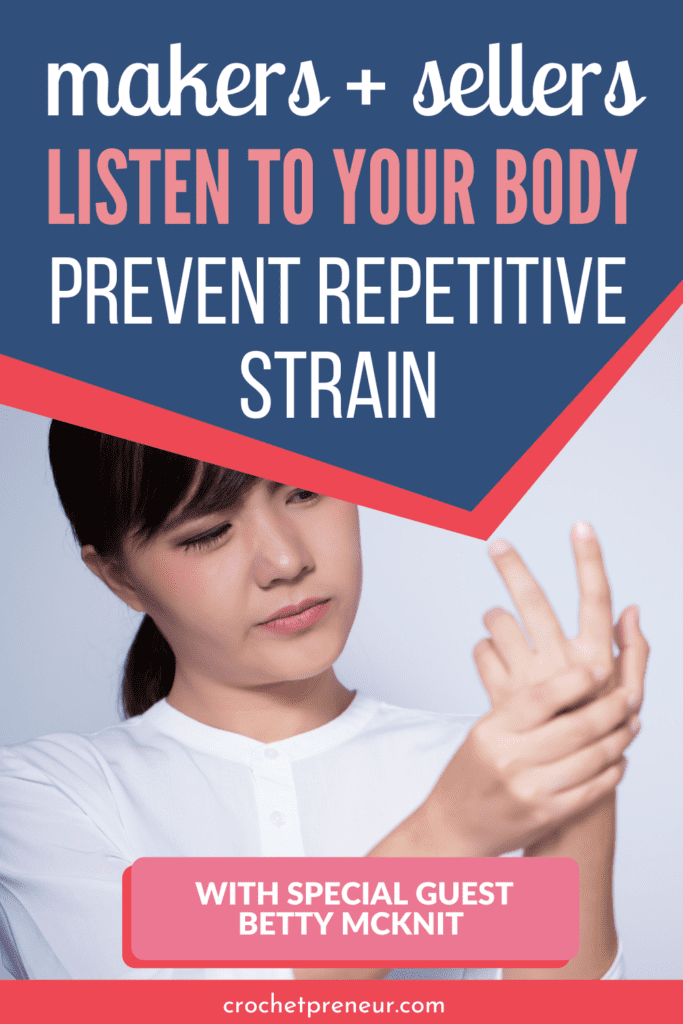
Crocheters: Taking Care of Your Body with Betty McKnit
Pam: [00:00:00] Hello, hello. Welcome to Crochet Business Chat. My name is Pam Grice. I am your crochet business coach, and I am on a mission to help 100,000 women find financial freedom through crochet. And I want to welcome you here today. We have something special for you. We do have a guest today. Our guest is Beth with Betty McKnit. If you haven’t seen her work, it’s just beautiful. She is the designer of the 6-Day Kid Blanket, which is just gorgeous. And she has a group. She’s doing a self-care crochet-a-long right now inside of her Facebook group. And you can find the link to that in the description of this video if you’d like to join her group and catch up on the crochet-a-long. I believe she’s going have an evergreen option with that as well.
Transcript: How Crocheters can Prevent Repetitive Strain
[00:01:31] So Beth is going to talk to us. She is a somatic practitioner. She helps folks who have repetitive motion issues and those kinds of things. I’m going to actually let her explain to you what she does. In the meantime, I would love to hear from you. Have you ever struggled with physical issues related to being a crochet business owner?
[00:02:03] There are so many things that may happen as far as repetitive motion injuries. I’m hearing a lot of people talk about shoulder injuries. Right now I have like a shoulder blade owie thing. So yeah, like repetitive things as far as working on crochet. And then there’s the working on the computer, and being on your phone, and constantly being in this position is so hard on the back and things like that. So we’re going to talk to Beth about how to pay attention to those things. So I’m going to go ahead and bring her on. Hi there.
Beth: [00:02:53] Hi.
Pam: Something happened with the Internet so I just went ahead and introduced you and started chatting while we waited for that to get resolved. So I’m glad you were able to make it back on. Katie said she has really sore shoulders and she has a trigger finger in her right middle finger that the doc says is caused by stress on her finger.
What is a Somatic Practitioner?
[00:03:27] So yeah. I was explaining that you are a somatic practitioner. Can you explain just a little bit about what somatic means? I think people in the therapeutic realm know what that means but I think lay people don’t. And then tell them a little bit about what you do as someone who practices this science and art.
Beth: [00:03:54] Thanks. Yeah. Somatic is a fancy word for body-oriented. I used to be a dancer and a yoga instructor so that’s how I came into somatic work and also through illness that seemed psychosomatic, which is a word that means your mind is causing your body to be sick or have problems. Yeah.
[00:04:27] So how it happens to come up in crochet is just in teaching and working with people, I’ve noticed people doing things like holding their breath. And of course you hear about people having injuries and repetitive problems from just crocheting so much. Especially those of us that are in business for crochet, we crochet every day. I crochet every day for hours, even on a slow day. Anything you do a lot of affects your body.
Pam: [00:05:08] So how do you help people in your business?
Beth: It’s just kind of seeped its way in because the somatic work is … I’m such a body-oriented person, having been a dancer. So for me when, I’m sitting down for a long time, that doesn’t feel comfortable. So I just kind of automatically get up and start doing some stretches or whatever. But I’ve just brought it in, little by little, just as I teach people ,as I notice that they’re holding their breath. So it just kind of snuck its way in.
How Can Crochet Business Owners Prevent Injury?
Pam: [00:05:52] It’s so great that you are both ends of this discussion, as far as everyone watching right now are crochet business owners. And then you are on the end of being a helper for people who are dealing with these kind of issues with their body being impacted by the way that they’re holding their body, holding their breath for long periods of time. So what can people who are crochet business owners do to protect themselves from injury or stresses on the body?
Take Breaks and Pause
Beth: [00:06:28]I think one of the most important things that we can do is take breaks and pause. But one thing I’ve noticed, that I’ve already mentioned, is the breathing. Paying attention to your breath is like somatic work 101. The breath is something that we can control. And when we’re not thinking about it, our body will take over. So when there’s something happening that’s stressing us out, or something we don’t like, or even when we’re learning a new stitch, we will hold our breath. So just like noticing the breath is the first thing, I think people could do.
[00:07:12] And then, obviously, you cannot sit in a chair all day long. You have got to get up out of your chair. I was recommending once an hour. So my habit is to pay attention to the 45 of the hour, and get up out of my chair, and stretch everything. But I was actually recently told by a health professional that it should be every 20 minutes.
Pam: Oh, wow.
Beth: I know, right.
Pam: [00:07:46] Okay. So I’m trying to think of how we can … A timer. I’m thinking the timer is the only … Like we’re so known for saying, “Okay, just one more row. I’m just going to do one more row and then I’ll do whatever it is I need to do.” And for me, one more row just reoccurs, and reoccurs, and reoccurs till hours have passed and I have not moved from where I’m at. So it really does take discipline.
Beth: [00:08:18] We just want to keep going, and going, and going. But if we do that, we’re going to break. Our bodies are going to break. And with somatic work, there’s also like a mind and spirit element to it, also. So I want to stop myself sometime and say, “Why is it that I think I can’t stop? Why do I think I have to just keep going?” Because we are really more productive when we stop and take breaks
Pay Attention to Your Breath
[00:08:54] So just kind of rolling back. I have a couple of habits that I’m trying to establish because when muscle memory starts going … You’re doing something a lot. Muscle memory takes over. So I try to take advantage of that. So one of the things that I try to do is whenever I pull my yarn—you know when you’re working on something and you want to pull a big, long thing of yarn—I take a deep breath when I do that. And then when I flip, I try to remember to take a deep breath then.
Pam: [00:09:26] That is so good. So you’re just training your body that this means inhale.
Beth: Big deep, breath. You’re probably holding your breath. You may be holding your breath. A lot of people.
Pam: I know that that’s something that I do. I hold my breath all the time and then I’ll be like, “Oh my gosh. I’m so out of breath and I’m just sitting here.” Of course my Fitbit is telling me I’m having a good workout when I’m crocheting. But it’s lying.
Get Up and Move
Beth: [00:10:00] That’s cheating. Then the other thing, I know I’m not getting up every 20 minutes out of my chair. But I try to pay attention to the clock. And I just started this around when the pandemic started and I noticed I was sitting down at a screen a lot more than usual. Now it just feels like normal but I came up with this idea the. At the 45 of the hour, I’m going to get up out of my chair, even if I’m on a meeting, no matter what it is I’m doing. On the 45 of the hour, if I am in a chair, I’m getting up.
Pam: So good. So now is your brain kind of catching up to that and you’re just doing it automatically or do you have to still tell yourself it’s time?
Beth: It’s, unfortunately not automatic. But did it in enough meetings that some of my followers will say, “Oh, Betty. It’s 45. You’re still in your chair.”
Making Self-Care a Habit
Pam: [00:11:00] That’s good. I’m mostly at my computer because you know I don’t crochet as much as most crochet business owners because it’s just part of my business. But when I get my new office, I’m getting a standing desk so that I can just automatically just push a button, and the desk stands up, and I have to go with it, and then hoping to use that to train myself to be more active because, right now, I’m just constantly sitting and I know it’s not good for me. And that’s probably why my shoulder hurts today So I think it’s so important.
[00:11:35] And really, if crochet business owners or anyone could see how taking care of your body is really beneficial for the longevity of your business, it’s like taking it from being an annoyance to, “This is a real benefit for me.” Kind of like taking your vitamins is kind of annoying but it’s really good for you. So we just do it because we recognize that it’s important. So kind of internalizing how important it is, I hope, would make it easier to develop those new habits
Beth: [00:12:15] Yeah. Self-care is difficult for a lot of us, just because we are giving people, especially if we’re mothers or parents, we give so much. When you’re an entrepreneur and you’re starting your own business, there’s always this sense of hustle. But just to bring our lives back to ourselves, sometimes. We’re living in these bodies and we only get one of them. And if something breaks down here, there’s nothing that we’re going to be able to give to the outside world. So self-care, as a habit, it’s not selfish. If we’re not taking care of ourselves, we’re not going to have anything for our business or for anybody else.
Seeking Professional Help
Pam: [00:13:10] Right. So important. So how can someone know …? They’re taking care of themselves. They’re recognizing, “Okay, I have shoulder pain. I’m going to do stretches. I’m going to do all these new things. How does a person know when it’s, “Okay. Taking care of myself is not working at this point. How do I know when to seek medical attention?”
Beth: [00:13:35] Yeah. Unfortunately, sometimes it does get to that point. But I would say if you’re having trouble opening your hand after crocheting for a long time, or and if you’re not using ergonomic hooks and you’re in the business of crochet, you need to just stop whatever you’re doing and find the right hook for your hand that allows your hand to relax while you’re working. And find the right hold—the right tension hold over the left hand—so that you can relax your hands while you’re working. And that will just give you so much more time to crochet and work.
[00:14:19] But if you notice you can’t move, you’ve lost mobility in any part of your body, if you’ve lost feeling and you have numbness in any part of your body, or if you have a sharp, shooting pain in anything, I would say it’s definitely time to stop, and put the crochet down, and call your doctor. Get some rest and get some attention for whatever’s happening.
Pam: [00:14:48] Yeah. That’s good advice. I think a lot of times, people, when they have to put down their hooks they start, they start feeling with guilt of like, “I’m supposed to be working.” But there’s so many other things to do in your business. We all know. We have marketing to do. We have other things to do besides crocheting that it’s okay to take a break. We push ourselves so hard to come out with the next product or the next design that sometimes we just need to really incorporate that break time into our businesses in order to protect ourselves and keep ourselves from having to go find professional help. But then, when you recognize that it’s time, then to do it
[00:15:29] I’m one of those people who’s constantly resistant of like, “No. If i just give it a week or so, it’ll work itself out,” and then it doesn’t, and then … But I really that it’s important to—
6-Days Of Self Care Crochet-A-Long
Beth: [00:15:40] I have a couple of people in my community right now that have not been able to crochet for months because of injury. And to be honest, that’s what inspired the Six Days Of Self-Care Crochet-A-Long because we missed having them. I missed them in my community. They’re still there but they’re not crocheting. I feel that loss. Crochet is a really big part of my life so if I was not able to crochet, I don’t know. That would feel really strange.
Pam: [00:16:20] I told everyone at the beginning … I gave them the links to your website and your Facebook group and told them that you have this self-care crochet-a-long going on. Is it too late for them to join or are they able to come into your group and play catch-up.
[Blog readers, this event has ended but you can still follow Betty McKnit on all of her various social media pages, listed below].
Find Betty McKnit on Social Media
Beth: [00:16:40] It’s not too late. Anybody can absolutely join. There’s actually a registration link to the Zoom call if you want to be part of the Zoom call. That’s on my Facebook page in the event. And then people could join the Facebook group for the 6-Day Kid Blanket and just follow along on the live stream there. Or if you want to join my membership community, it’s called the Betty McKnitiverse. I have community calls like this every other week. So we have a lot of community there. And yeah. There’s bi-monthly calls and—bi-monthly is that or bi-weekly? We do it twice a month.
Pam: [00:17:31] I know that word is so hard. What does it even mean? So how can people find your Facebook page to connect with you?
Beth: It’s my Betty McKnit page on Facebook. I’m on Instagram, TikTok. I’m on all the places as Betty McKnit.
Pam: And you’re doing great on TikTok, doing lives and connecting with people. I think it’s so awesome. So good. I haven’t done a live on TikTok yet but I’ve seen yours. So I’m so proud of you and glad to be your friend and supporter in your business.
[00:18:09] I really just want to encourage people that, even if you don’t want to make a blanket or the 6-Day Kid Blanket, I would still really recommend that you join Beth’s community and connect with her and her people, if only for the community aspect of it and for those connection points of being able to chat with her about self-care and connecting with other crocheters. So if you’re looking for an active community where people are really connecting, then I really recommend you check out her page, her Facebook group, and her membership.
Advice for Viewers
[00:18:51] Would you be okay with taking some questions from folks who are here?
Beth: Absolutely. But before I do that, I just wanted to say thank you for that. And I also want to say thank you for everything that you do in CBA and for your coaching over the past year. It has really up-leveled my business to be part of CBA. It’s really made me feel legitimate and like a real CEO.
Pam: Yay! Thanks. I’m so glad to hear that. I love that you’re in our community. I love to connect with you and see you in our Zoom calls and everything.
Beth: Thank you. I’d better show up now.
Pam: I know. It’s hard. For me, I belong to so many courses. And there’s so many Zoom calls. Like every day, I could pop on a Zoom call. So I have to be picky about which ones I connect with and which ones I don’t. That’s why I’m glad that I have my own because I have to be there.
Beth: Yours are priority for me. So I just want you to know that.
Pam: [00:19:54] Thank you. All right. Let’s see. We’re getting headaches, wrist pain. Same here. Carol was saying the Pomodoro Method. That’s what I was thinking when you were talking is to use the Pomodoro Method not only for productivity in your business but to remind you to get up. So do your 20-25 minutes of Pomodoro and then get up and move around and do your stretches. And maybe take 10 deep breaths before you get back to work. Could be really helpful.
Help for Headaches
Beth:[00:20:28] Also, for the person that mentioned headaches., we don’t really think about our eye health sometimes and how we’re just like looking at something that’s so close. So if you can get outside or even look out the window and allow your eyes to focus on something really far away for a while and give your eyes that rest.
[00:21:05] And if you’re having headaches, I’m thinking that there might be something happening in the neck or the shoulders. So posture is so important when you’re crocheting. Put a pillow on your lap. Remember those Boppy pillows from when you were nursing a baby? Those are perfect. Get a Boppy pillow or just a pillow and put it on your lap and put your work on that so that you’re not always in this position with your head.
[00:21:40] When you see me crochet, I’m packed in like, I don’t know, a fish in ice or something. I have pillows that support my arms and I have pillows that support my work. And I’m supporting my back so that I can just relax. My body is doing the least amount of work possible. Everything is being supported—my whole body. My legs are supported. I have my feet up, my arms, and I’m just crocheting.
Self-Care for Your Spine
Pam: [00:22:11] I find that it’s so much more comfortable for me to also have my feet up. My crochet chair is a recliner and I’m able to micro-adjust it to exactly where I need it to be so that … I have spinal stenosis in my cervical spine so I have to really take care of that. And so having that recliner really does help me. So that’s an important thing. Getting your feet up, I think, is really helpful.
Beth: [00:22:39] I think a lot of us have problems with this. I think it’s the C4. I don’t really know it that good but where you get the hump. I meant to have it available for this slide but I have one of those things called a peanut. And you can actually make one by putting two tennis balls in a sock. And then lean against a wall or lay down with those tennis balls, one on either side of the spine. Don’t put it right on the spine but on either side. And you can always lean on a wall with a tennis ball. You can control the tension—how hard you press on that. But you can work out some of the tension and the strain and stress that we put on this.
[00:23:30] We’re all doing it. I think it’s like called text neck or whatever. We all have it because the thing in our culture we’re always looking at our phones. But you can do a little self-care there. And then, at night when I go to bed, every night I stack up my pillows and I lay back over my pillows so that I’m in extension. I’m in spinal extension. My shoulders are open because we have our shoulders [inaudible] all the time. So we want to go the opposite way with the head back. That’s how I start my nighttime routine, is just by opening up and breathing there for maybe like 10 minutes. And it feels great. It feels really good. So those are some physical things I could recommend for people.
Preventing Wrist Pain
[00:24:29] And somebody said wrist pain a while ago. Did we talk about that?
Pam: We haven’t talked about it. If you have ideas about that, that’d be great.
Beth: I do. When you’re stretching, a lot of people don’t know how to stretch. So when you’re stretching, what you’re doing is …. Like I have my hands always like this when I’m crocheting. So all this is in flexion so I want to make extension.And then, because a lot of us are so perfectionists, we’re like [bends fingers back dramatically]. Don’t do that. Just nice and gently and nice breaths will help.
[00:25:12] And then I had another thought about that. This is the ergonomic hook that I use for wrist. If you have this knife hold—I wish I held like this but I suppose that you could do that, too—learn to use your finger dexterity as well as your wrist so you reduce the action of the wrist so much and/or you have options for how you change up your move movement of crochet. But relax your hands as much as you can when you’re working relax your shoulders. Relax your arms. Have everything supported so you can relax and enjoy it.
Pam: [00:26:04] Carol had mentioned to alternate between knitting and crochet or Tunisian and non-Tunisian, which is what I do. I alternate between regular crochet and Tunisian crochet. Because Tunisian, for me, is so much more relaxing because I’m just kind of doing this and it’s just gentle movements, whereas when I’m crocheting, I’m like a lot of wrist movement. So finding different ways of moving is so important
Beth: [00:26:32] I like the 6-Day Kid Blanket because it has different types of stitches. Some require concentration and others are just like …
Wrapping Up
Pam: [00:26:43] Great. Well, those are all of our questions so I’m going to close us up. Thank you so much for coming. Everyone is saying how wonderful these suggestions are. And appreciate your time. Really, it’s just great to have that reminder that it’s important to take time to take care of your body as much as it is important to take care of your business and your family. Taking care of you and finding simple ways to incorporate that into your day, even if you have to set a timer and learn to be more disciplined about just one more row means one. It doesn’t mean 20. It means one. Finish up the row.
Beth: Let’s not think of it as discipline. Let’s think of it as loving ourselves and loving our bodies to do this for ourselves first so we can be there for others. Really, self-love. Self-care is self-love.
Pam: [00:27:44] Well, thank you so much for taking the time to speak with us today. Again, for those of you watching, if you’re watching the replay you can look on Facebook for Betty McKnitiverse? BettyMcKnit.com is where you’ll find the membership community and all those links will be in the description so you can grab that.And if you are looking for more crochet business tips and encouragement, be sure to subscribe to this channel and hit the notification bell so that you don’t miss out on any videos that are upcoming. And I’m so glad that you’re here and I will see you next Monday. Thank you, Beth. It was great to see you. I appreciate you. Okay. Bye. It’s ending.



